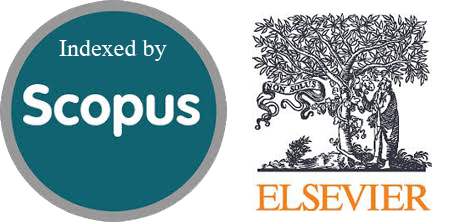The Effect of Hyperparameters on Faster R-CNN in Face Recognition Systems
Abstract
Face recognition is one of the main challenges in the development of computer vision technology. This study aims to develop a face recognition system using a Faster R-CNN architecture, optimized through hyperparameter tuning. This research utilizes the "Face Recognition Dataset" from Kaggle, which comprises 2,564 face images across 31 classes. The development process involves creating bounding boxes using the LabelImg application and implementing the Grid Search method. The Grid Search is applied with predefined hyperparameter combinations (3 epochs [10, 25, and 50] × 3 learning rates [0.001, 0.0001, and 0.00001] × 3 optimizers [SGD, Adam, and RMS], resulting in 27 models). The evaluation metrics used were accuracy, precision, recall, and F1-score. The experimental results show that the selection of hyperparameters significantly affects the model performance. Based on the experimental results, the combination of the learning rate 0.00001, 50 epochs, and Adam optimizer yielded the highest accuracy and improvement of 8.33% compared to the baseline model. The results indicate that hyperparameter optimization enhances the ability of the model to recognize faces. Compared to conventional models, a Faster R-CNN performs better in detecting faces more accurately. Future research could further enhance the face recognition efficiency and accuracy by exploring other deep learning architectures and more advanced hyperparameter optimization techniques.
Downloads
References
F. Boutros, N. Damer, F. Kirchbuchner, and A. Kuijper, “ElasticFace: Elastic Margin Loss for Deep Face Recognition,” IEEE Comput. Soc. Conf. Comput. Vis. Pattern Recognit. Work., vol. 2022-June, pp. 1577–1586, 2022, doi: 10.1109/CVPRW56347.2022.00164.
M. Wang and W. Deng, “Deep face recognition: A survey,” Neurocomputing, vol. 429, pp. 215–244, 2021, doi: 10.1016/j.neucom.2020.10.081.
P. Payal and M. M. Goyani, “A comprehensive study on face recognition: methods and challenges,” Imaging Sci. J., vol. 68, no. 2, pp. 114–127, 2020, doi: 10.1080/13682199.2020.1738741.
M. Feurer and F. Hutter, "Parameter Optimization, (eds) Automated Machine Learning," The Springer Series on Challenges in Machine Learning. Springer, Cham., doi: 10.1007/978-3-030-05318-5_1.
M. T. H. Fuad et al., “Recent advances in deep learning techniques for face recognition,” IEEE Access, vol. 9, no. July, pp. 99112–99142, 2021, doi: 10.1109/ACCESS.2021.3096136.
H. Yan, X. Wang, Y. Liu, Y. Zhang, and H. Li, “A new face detection method based on Faster RCNN,” J. Phys. Conf. Ser., vol. 1754, no. 1, 2021, doi: 10.1088/1742-6596/1754/1/012209.
M. Zhou, B. Li, and J. Wang, “Optimization of Hyperparameters in Object Detection Models Based on Fractal Loss Function,” Fractal Fract., vol. 6, no. 12, 2022, doi: 10.3390/fractalfract6120706.
J. Selvaganesan et al., “Enhancing face recognition performance: a comprehensive evaluation of deep learning models and a novel ensemble approach with hyperparameter tuning,” Soft Comput., 2024, doi: 10.1007/s00500-024-09954-y.
Kaggle, “Face Recognition Dataset,” 2021, [Online]. Available: https://www.kaggle.com/datasets/vasukipatel/face-recognition-dataset/data
R. J.Hassan and A. M. Abdulazeez, “Deep Learning Convolutional Neural Network for Face Recognition: A Review,” Int. J. Sci. Bus., vol. 5, no. 2, pp. 114–127, 2021, doi: 10.5281/zenodo.4471013.
L. Alzubaidi et al., "Review of deep learning: concepts, CNN architectures, challenges, applications, future directions," Journal of Big Data, vol. 8, no. 53, 2021, doi: 10.1186/s40537-021-00444-8.
S. B. Mane, N. Shah, V. Garje and A. Tejwani, "A Comprehensive Survey of Face Recognition Advancements," 2024 8th International Conference on Computing, Communication, Control and Automation (ICCUBEA), Pune, India, 2024, pp. 1-5, doi: 10.1109/ICCUBEA61740.2024.10774962.
L. Li, X. Mu, S. Li, and H. Peng, “A Review of Face Recognition Technology,” IEEE Access, vol. 8, pp. 139110–139120, 2020, doi: 10.1109/ACCESS.2020.3011028.
J. Liu, “Face recognition technology based on ResNet-50,” Appl. Comput. Eng., vol. 39, no. 1, pp. 160–165, 2024, doi: 10.54254/2755-2721/39/20230593.
S. Ren, K. He, R. Girshick, and J. Sun, “Faster R-CNN: Towards Real-Time Object Detection with Region Proposal Networks,” IEEE Trans. Pattern Anal. Mach. Intell., vol. 39, no. 6, pp. 1137–1149, Jun. 2015, doi: 10.1109/TPAMI.2016.2577031.
K. He, X. Zhang, S. Ren, and J. Sun, “Deep residual learning for image recognition,” Proc. IEEE Comput. Soc. Conf. Comput. Vis. Pattern Recognit., vol. 2016-Decem, pp. 770–778, 2016, doi: 10.1109/CVPR.2016.90.
B. Mandal, A. Okeukwu, and Y. Theis, “Masked Face Recognition using ResNet-50,” arXiv, 2021, doi: 10.48550/arXiv.2104.08997
G. Ghiasi, T. Y. Lin, and Q. V. Le, “NAS-FPN: Learning scalable feature pyramid architecture for object detection,” Proc. IEEE Comput. Soc. Conf. Comput. Vis. Pattern Recognit., pp. 7029–7038, 2019, doi: 10.1109/CVPR.2019.00720.
K. H. Shih, C. Te Chiu, J. A. Lin, and Y. Y. Bu, “Real-Time Object Detection with Reduced Region Proposal Network via Multi-Feature Concatenation,” IEEE Trans. Neural Networks Learn. Syst., vol. 31, no. 6, pp. 2164–2173, 2020, doi: 10.1109/TNNLS.2019.2929059.
R. Girshick, “Fast R-CNN,” Proc. IEEE Int. Conf. Comput. Vis., pp. 1440–1448, 2015, doi: 10.1109/ICCV.2015.169.
S. A. K. Mohammed, A. H. A. Rahman, M. A. Bakar, and M. Z. A. Razak, “An Efficient Intersection Over Union Algorithm with Angle Orientation for an Improved 3D Object Detection,” 6th IEEE Int. Conf. Artif. Intell. Eng. Technol. IICAIET 2024, pp. 312–316, 2024, doi: 10.1109/IICAIET62352.2024.10730667.
J. Hosang, R. Benenson, and B. Schiele, “Learning non-maximum suppression,” Proc. - 30th IEEE Conf. Comput. Vis. Pattern Recognition, CVPR 2017, pp. 6469–6477, 2017, doi: 10.1109/CVPR.2017.685.
M. -C. Roh and J. -y. Lee, "Refining faster-RCNN for accurate object detection," 2017 Fifteenth IAPR International Conference on Machine Vision Applications (MVA), Nagoya, Japan, 2017, pp. 514-517, doi: 10.23919/MVA.2017.7986913.
H. Rezatofighi, N. Tsoi, J. Gwak, A. Sadeghian, I. Reid, and S. Savarese, “Generalized intersection over union: A metric and a loss for bounding box regression,” Proc. IEEE Comput. Soc. Conf. Comput. Vis. Pattern Recognit., pp. 658–666, 2019, doi: 10.1109/CVPR.2019.00075.
T. Yu and H. Zhu, “Hyper-Parameter Optimization: A Review of Algorithms and Applications,” arXiv, 2020, doi: 10.48550/arXiv.2003.05689
A. Prasetya, C. Fatichah, and U. L. Yuhana, “Parsing the semantic structure of Indonesian math word problems using the recursive neural network,” Regist. J. Ilm. Teknol. Sist. Inf., vol. 5, no. 2, pp. 106–115, 2019, doi: 10.26594/register.v5i2.1537.
C. Hu, P. Coen-Pirani, and X. Jiang, “Empirical Study of Overfitting in Deep FNN Prediction Models for Breast Cancer Metastasis,” arXiv, 2022, doi: 10.48550/arXiv.2208.02150.
A. Johny and K. N. Madhusoodanan, “Dynamic Learning Rate in Deep CNN Model for Metastasis Detection and Classification of Histopathology Images,” Comput. Math. Methods Med., vol. 2021, 2021, doi: 10.1155/2021/5557168.
D. Irfan, T. S. Gunawan, and W. Wanayumini, “Comparison Of SGD, Rmsprop, and Adam Optimation In Animal Classification Using CNNs,” Int. Conf. Inf. Sci. Technol. Innov., vol. 2, no. 1, pp. 45–51, 2023, doi: 10.35842/icostec.v2i1.35.
M. Breton and P. Eng, “Overview of two performance metrics for object detection algorithms evaluation,” Def. Res. Dev. Canada Ref. Doc., no. December, 2019.
R. Padilla, S. L. Netto, and E. A. B. Da Silva, “A Survey on Performance Metrics for Object-Detection Algorithms,” Int. Conf. Syst. Signals, Image Process., vol. 2020-July, no. July, pp. 237–242, 2020, doi: 10.1109/IWSSIP48289.2020.9145130.
Kaggle, “Face Recognition with Resnet50.” [Online]. Available: https://www.kaggle.com/code/sushanshrestha0690/face-recognition-with-resnet50
D. Choi, C. J. Shallue, Z. Nado, J. Lee, C. J. Maddison, and G. E. Dahl, “On Empirical Comparisons of Optimizers for Deep Learning,” arXiv, 2020, doi: 10.48550/arXiv.1910.05446.
S. Nurdiati, M. K. Najib, F. Bukhari, R. Revina, and F. N. Salsabila, “Performance Comparison Of Gradient-Based Convolutional Neural Network Optimizers For Facial Expression Recognition,” BAREKENG: Journal of Mathematics and Its Applications, vol. 16, no. 3, pp. 927–938, 2022, doi: 10.30598/barekengvol16iss3pp927-938.
M. Kim, A. K. Jain, and X. Liu, “AdaFace : Quality Adaptive Margin for Face Recognition” arXiv, 2023, doi: 10.48550/arXiv.2204.00964.
M. E. A. Ali and D. Kumar, “The Impact of Optimization Algorithms on The Performance of Face Recognition Neural Networks,” J. Adv. Eng. Comput., vol. 6, no. 4, p. 248, 2022, doi: 10.55579/jaec.202264.370.
M. E. Teo, L. Y. Chong, S. C. Chong, and P. Y. Goh, “2.5D Face Recognition System using EfficientNet with Various Optimizers,” Int. J. Informatics Vis., vol. 8, no. 4, pp. 2388–2399, 2024, doi: 10.62527/joiv.8.4.3030.
S. Hamid, H. Madni, H. Muhammad, F. Shahzad, S. Shah, and M. Faheem, “Exploring optimizer efficiency for facial expression recognition with convolutional neural networks,” The Journal of Engineering, vol. 2025, no. 1, pp. 1–29, 2025, doi: 10.1049/tje2.70060.
D. Bashir, G. D. Montañez, S. Sehra, P. S. Segura, and J. Lauw, “An Information-Theoretic Perspective on Overfitting and Underfitting,” Lect. Notes Comput. Sci. (including Subser. Lect. Notes Artif. Intell. Lect. Notes Bioinformatics), vol. 12576 LNAI, pp. 347–358, 2020, doi: 10.1007/978-3-030-64984-5_27.
O. A. Montesinos López, A. Montesinos López, and J. Crossa, "Multivariate Statistical Machine Learning Methods for Genomic Prediction," Springer, 2022. doi: 10.1007/978-3-030-89010-0.
Copyright (c) 2025 Jurnal RESTI (Rekayasa Sistem dan Teknologi Informasi)

This work is licensed under a Creative Commons Attribution 4.0 International License.
Copyright in each article belongs to the author
- The author acknowledges that the RESTI Journal (System Engineering and Information Technology) is the first publisher to publish with a license Creative Commons Attribution 4.0 International License.
- Authors can enter writing separately, arrange the non-exclusive distribution of manuscripts that have been published in this journal into other versions (eg sent to the author's institutional repository, publication in a book, etc.), by acknowledging that the manuscript has been published for the first time in the RESTI (Rekayasa Sistem dan Teknologi Informasi) journal ;






